Grigori Rasputin Worksheets
Do you want to save dozens of hours in time? Get your evenings and weekends back? Be able to teach about Grigori Rasputin to your students?
Our worksheet bundle includes a fact file and printable worksheets and student activities. Perfect for both the classroom and homeschooling!
Resource Examples
Click any of the example images below to view a larger version.
Fact File
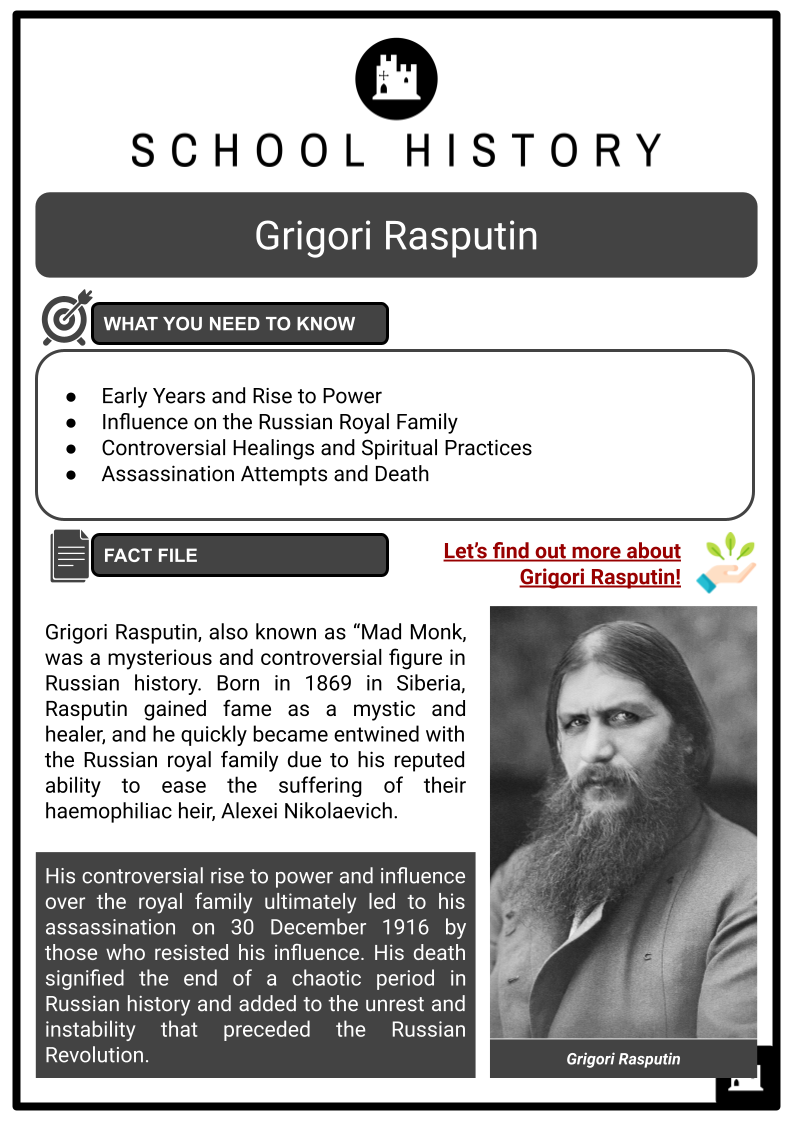
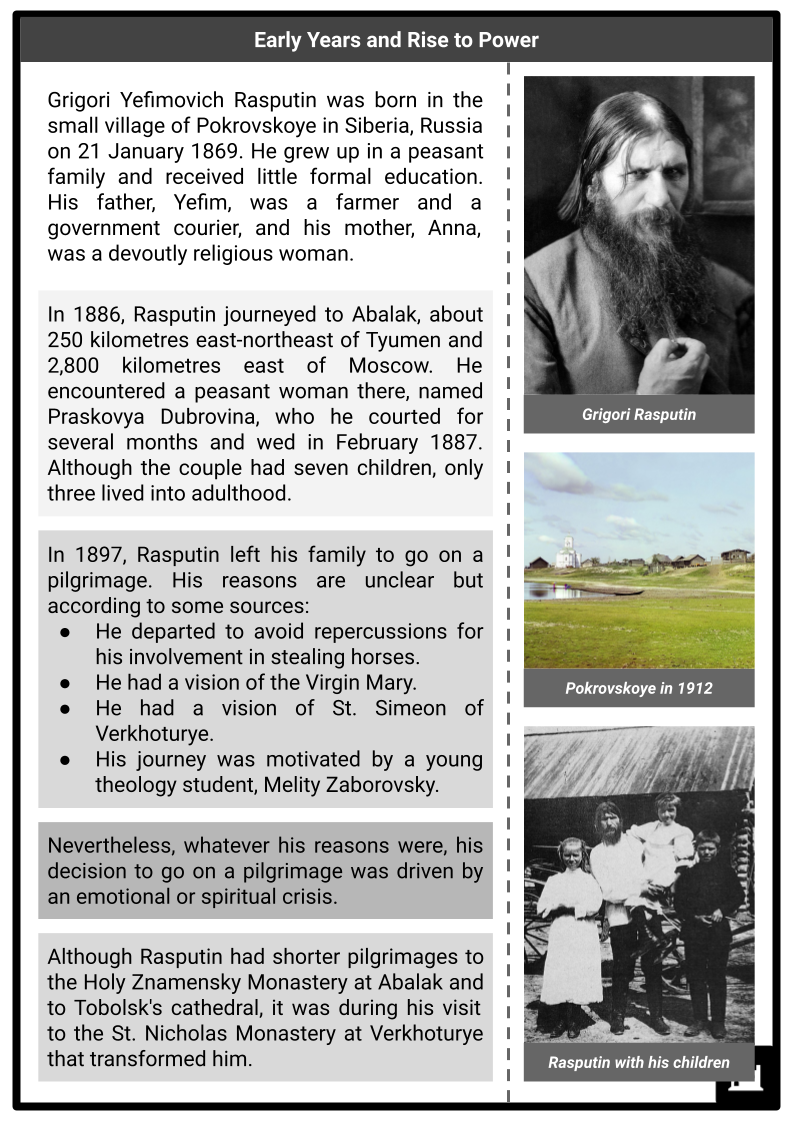
Student Activities
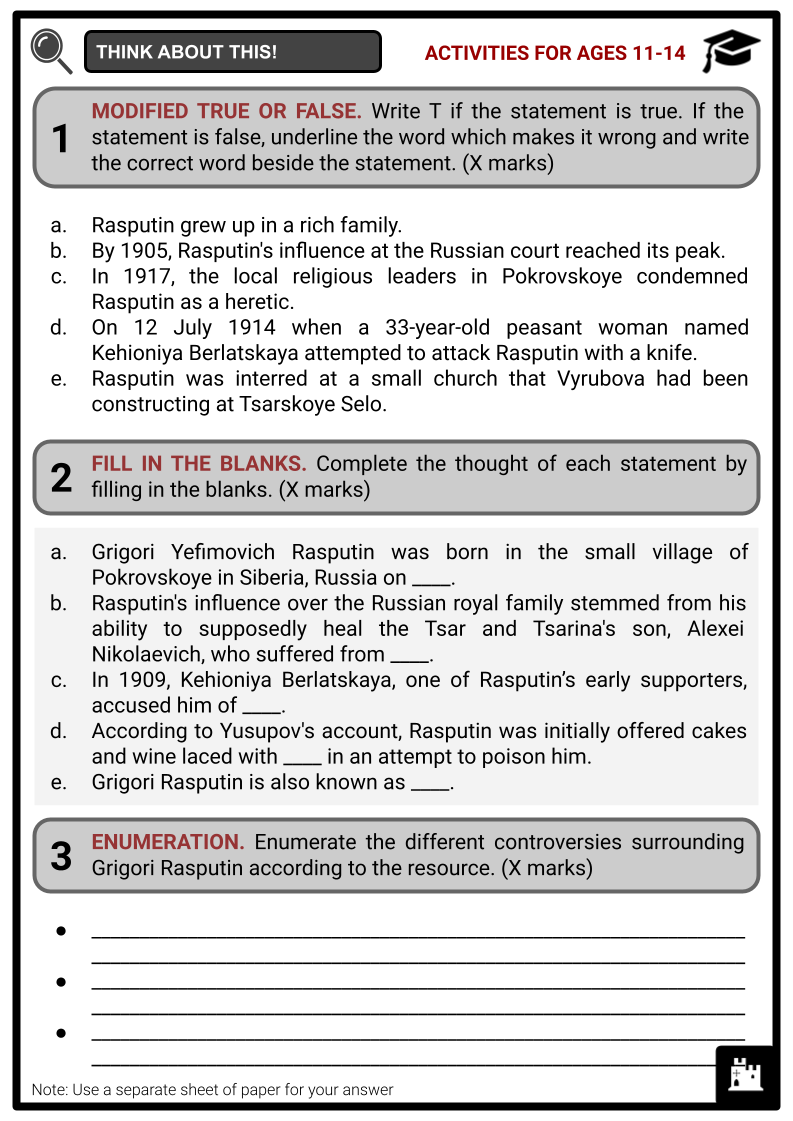
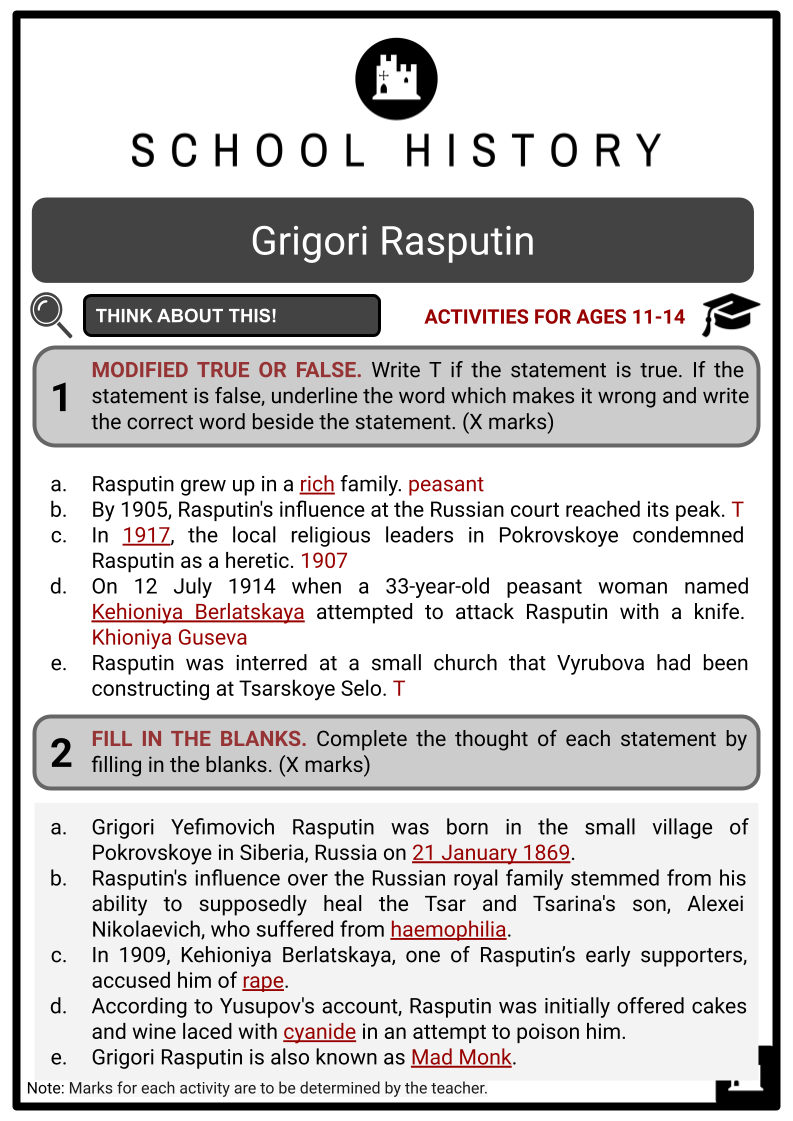
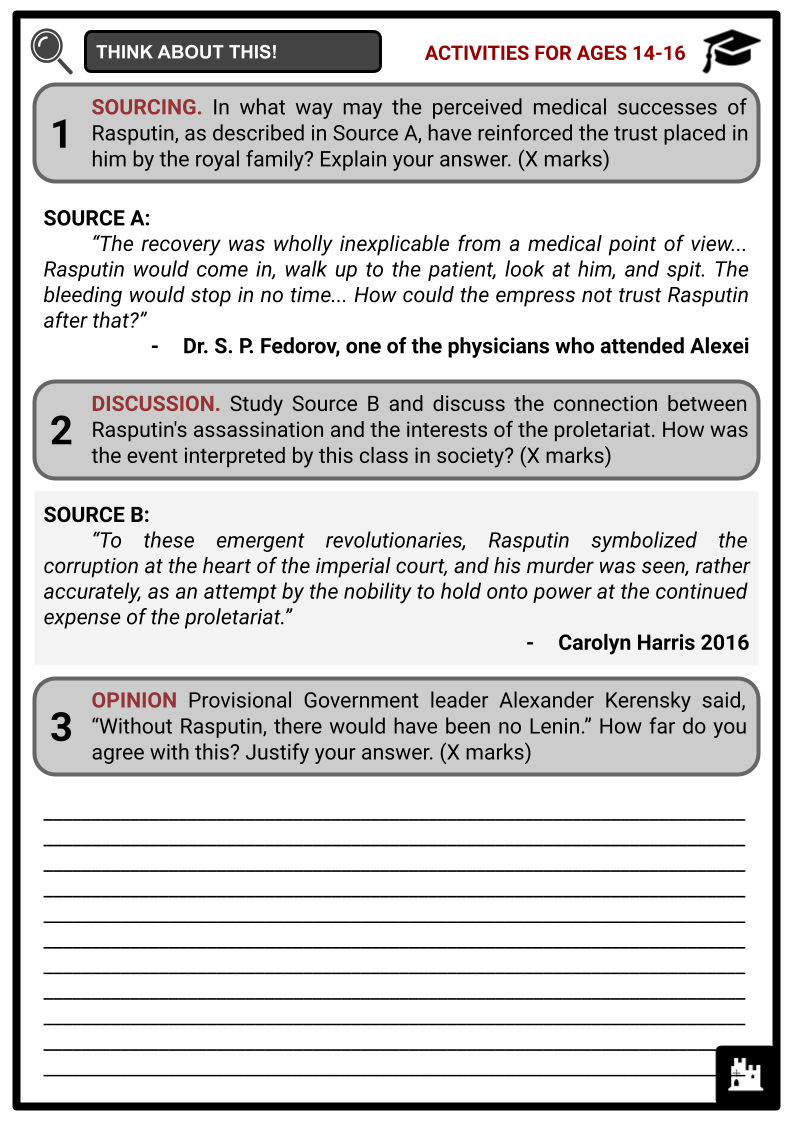
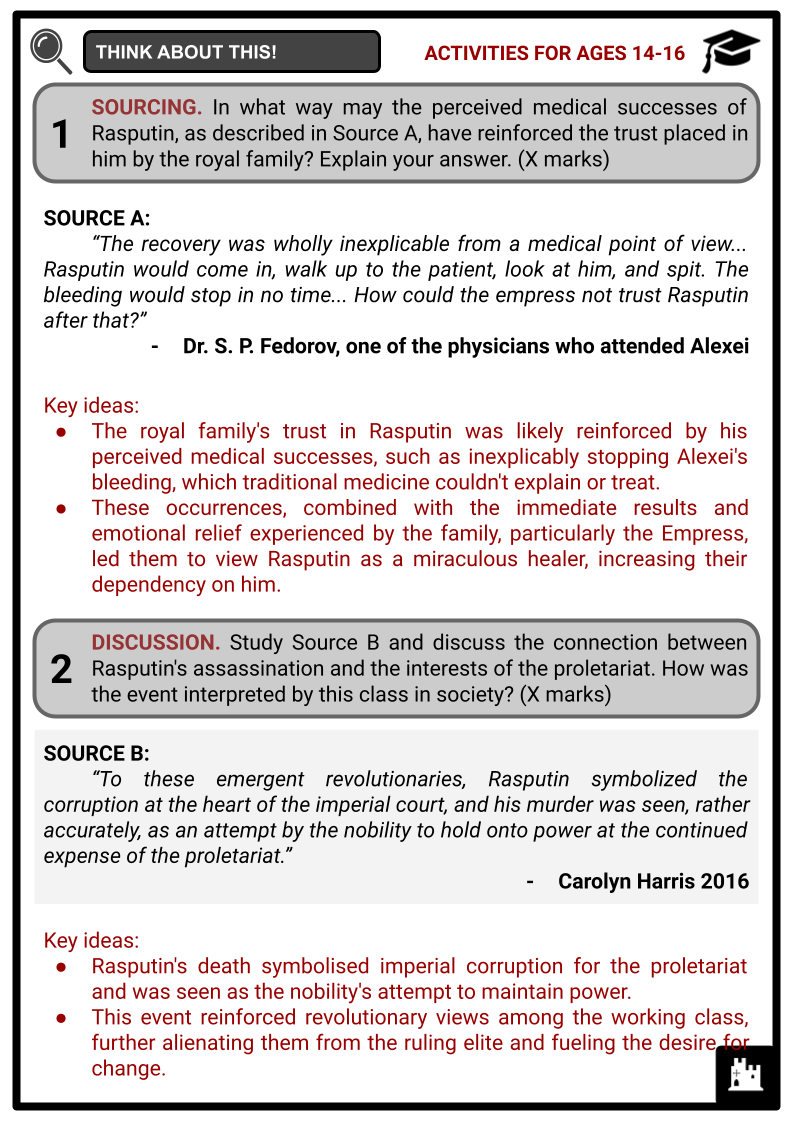
Summary
- Early Years and Rise to Power
- Influence on the Russian Royal Family
- Controversial Healings and Spiritual Practices
- Assassination Attempts and Death
Key Facts And Information
Let’s find out more about Grigori Rasputin!
Grigori Rasputin, also known as “Mad Monk, was a mysterious and controversial figure in Russian history. Born in 1869 in Siberia, Rasputin gained fame as a mystic and healer, and he quickly became entwined with the Russian royal family due to his reputed ability to ease the suffering of their haemophiliac heir, Alexei Nikolaevich. His controversial rise to power and influence over the royal family ultimately led to his assassination on 30 December 1916 by those who resisted his influence. His death signified the end of a chaotic period in Russian history and added to the unrest and instability that preceded the Russian Revolution.
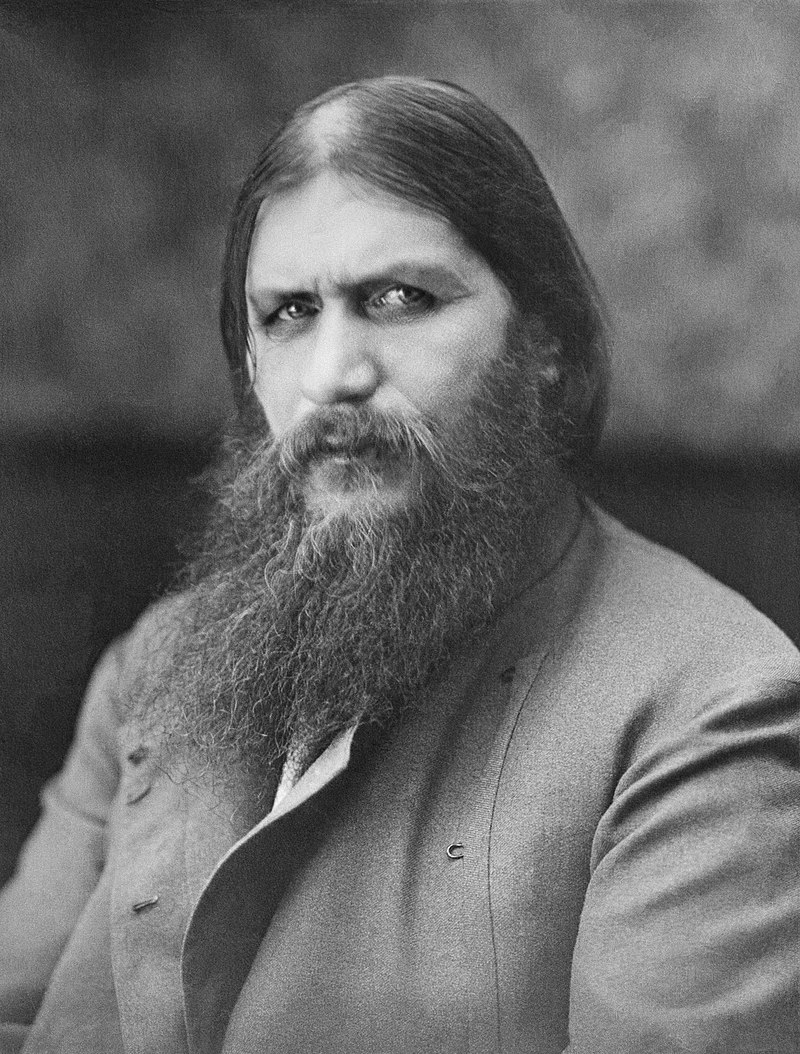
Early Years and Rise to Power
- Grigori Yefimovich Rasputin was born in the small village of Pokrovskoye in Siberia, Russia on 21 January 1869. He grew up in a peasant family and received little formal education. His father, Yefim, was a farmer and a government courier, and his mother, Anna, was a devoutly religious woman.
- In 1886, Rasputin journeyed to Abalak, about 250 kilometres east-northeast of Tyumen and 2,800 kilometres east of Moscow. He encountered a peasant woman there, named Praskovya Dubrovina, who he courted for several months and wed in February 1887. Although the couple had seven children, only three lived into adulthood.
- In 1897, Rasputin left his family to go on a pilgrimage. His reasons are unclear but according to some sources:
- He departed to avoid repercussions for his involvement in stealing horses.
- He had a vision of the Virgin Mary.
- He had a vision of St. Simeon of Verkhoturye.
- His journey was motivated by a young theology student, Melity Zaborovsky.
- Nevertheless, whatever his reasons were, his decision to go on a pilgrimage was driven by an emotional or spiritual crisis.
- Although Rasputin had shorter pilgrimages to the Holy Znamensky Monastery at Abalak and to Tobolsk's cathedral, it was during his visit to the St. Nicholas Monastery at Verkhoturye that transformed him.
- After staying there for a few months, he returned to Pokrovskoye a changed man. He adopted a vegetarian diet, decided to abstain from alcohol, and prayed and sang with increased passion compared to his previous habits.
- Rasputin wandered as a strannik (a holy wanderer or pilgrim) for several years, leaving Pokrovskoye for extended periods to travel the country and visit a range of sacred places. By the beginning of the 20th century, Rasputin had gathered a small group of devotees, mostly consisting of his relatives and local villagers. They constructed an improvised chapel in Yefim's underground storage area where they conducted secret prayer gatherings.
- Later on, Rasputin's influence and charm started to gain attention in Siberia. He impressed local religious figures such as Archimandrite Andrei and Bishop Chrysthanos, earning a letter of recommendation to Bishop Sergei from them. This paved the way for his journey to Saint Petersburg.
- At Alexander Nevsky Lavra, Rasputin met with church leaders, including Archimandrite Theofan, who was influential in Saint Petersburg society and later became confessor to the imperial family. Impressed by Rasputin, Theofan invited him to stay at his home and eventually became one of Rasputin's key allies in Saint Petersburg. This connection granted Rasputin access to important social gatherings where he gained early followers.
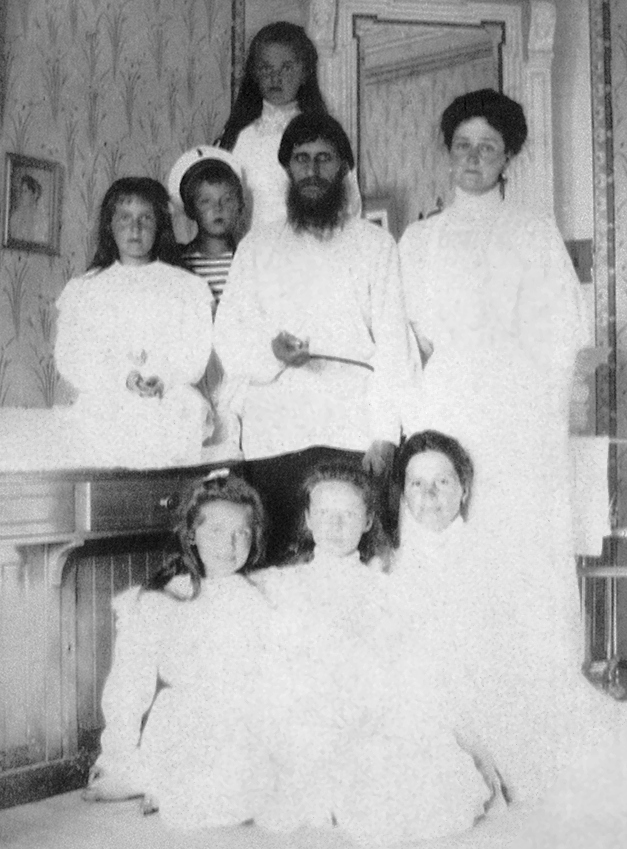
- Rasputin's pilgrimage experiences led him to believe that he had received a religious calling and had been chosen by God to be a healer and prophet. Over time, he gained a reputation as a mystic and holy man with supposed healing powers. His enigmatic persona and rumoured ability to heal the sick created a mystique around him, attracting followers and supporters.
Influence on the Russian Royal Family
- By 1905, Rasputin's influence at the Russian court reached its peak. He became a close confidant of Tsar Nicholas II and his wife, Empress Alexandra. Despite facing significant opposition from the nobility and clergy, his hold over the royal couple remained strong.
- Rasputin's influence over the Russian royal family stemmed from his ability to supposedly heal the Tsar and Tsarina's son, Alexei Nikolaevich, who suffered from haemophilia. After learning about Alexei's condition in October 1906, he was called upon by Alexandra to pray for the tsarevich when he suffered from an internal haemorrhage in the spring of 1907. Alexei showed signs of recovery the next morning.
- Soon after this event, Alexandra's friend Anna Vyrubova became convinced that Rasputin possessed miraculous abilities and emerged as one of his most prominent supporters.
- In the summer of 1912, Alexei suffered a haemorrhage in his thigh and groyne after a bumpy carriage ride, resulting in a large hematoma. In immense pain and feverish delirium, the tsarevich was believed to be on the brink of death. Desperate for help, Alexandra requested Vyrubova to send Rasputin, who was then in Siberia, a telegram asking him to pray for Alexei. Rasputin responded promptly with words of reassurance.
- Despite no change in Alexei's condition the next morning, Alexandra found some solace in Rasputin's message and regained hope that he would survive.
- Surprisingly, Alexei’s bleeding ceased by the following day which left Dr. S. P. Fedorov puzzled as he acknowledged that "the recovery was entirely inexplicable from a medical perspective."
- This reliance on Rasputin as a healer and confidant gave him unprecedented access to the inner workings of the royal household and allowed him to exert considerable influence over matters of state. As his influence grew, he began to interfere in political appointments and affairs, often appointing his own candidates to positions of power.
- This led to resentment and opposition from the nobility and political elites who saw him as an uneducated and uncouth outsider meddling in state affairs. His actions further worsened the existing tensions within the Romanov dynasty and contributed to the growing disillusionment with the imperial rule.
Controversial Healings and Spiritual Practices
- Rasputin's controversial healings and spiritual practices have been a subject of much debate and scrutiny. His reputation as a mystic with supposed healing powers drew both followers and detractors, and his methods have sparked controversy and acknowledgement from various quarters.
- One of the most controversial aspects of Rasputin's spiritual practices was his unorthodox methods of healing. He claimed to have the ability to heal the sick through prayer, touch, and intense spiritual communion. His supporters hailed him as a miracle worker, citing numerous instances where individuals claimed to have been cured of ailments after seeking Rasputin's assistance.
- However, his detractors accused him of exploiting the vulnerable and performing fraudulent healings. They argued that his methods lacked scientific basis and were rooted in superstition rather than genuine medical knowledge. The lack of transparency in his healing sessions and the absence of verifiable evidence added to the scepticism surrounding his supposed abilities. Rasputin's influence with the Russian royals sparked rumours and concerns about his control over state matters.
- Many viewed his position as an unwarranted intrusion into matters of governance and questioned the legitimacy of his authority in political and administrative decisions. In 1907, the local religious leaders in Pokrovskoye condemned Rasputin as a heretic, and the Bishop of Tobolsk initiated an investigation into his actions, alleging that he was "spreading false doctrines similar to the Khlysts".
- In Saint Petersburg, Rasputin encountered opposition from important figures such as Prime Minister Pyotr Stolypin and the Okhrana, the tsar's secret police. Despite ordering an inquiry into Rasputin's behaviour, Stolypin failed to control Rasputin's influence or force him out of Saint Petersburg.
- Beyond the royal circle, Rasputin taught that physical contact with him purged others. He participated in excessive drinking and had extramarital relationships with various women ranging from prostitutes to high-society ladies.
- In 1909, Kehioniya Berlatskaya, one of Rasputin’s early supporters, accused him of rape. Betlatskaya sought help from Theofan who became convinced that Rasputin posed a threat to the monarchy. Rumours circulated about assaults on female followers by Raspuitn and inappropriate conduct during visits with the imperial family—especially involving Nicholas's teenage daughters Olga and Tatiana.
Assassination Attempts and Death
- Rasputin's increasing influence and controversial reputation made him a target for several assassination attempts. The first recorded attempt on his life occurred on 12 July 1914 when a 33-year-old peasant woman named Khioniya Guseva attempted to attack him with a knife.
- She managed to wound him, but Rasputin survived the attack, which only served to enhance his mystique and reinforce his perceived invincibility.
- Guseva was a supporter of Iliodor, an ex-clergyman who initially backed Rasputin but later exposed his sexual activities and excessive self-importance in December 1911. Iliodor, known for his extreme conservative views and anti-Semitic beliefs, had joined others in trying to create discord between Rasputin and the imperial family in 1911. After this plot failed, Iliodor was expelled from Saint Petersburg and eventually stripped of his religious status.
- Guseva stated that she acted independently after reading about Rasputin in the newspapers and viewing him as a fraudulent prophet and an Antichrist. Nonetheless, both the authorities and Rasputin suspected that Iliodor had incited the assassination attempt. Before being questioned, Iliodor fled the country, while Guseva was deemed not accountable for her actions due to insanity.
- The death of Rasputin remains a subject of intrigue and speculation. A coalition of aristocrats, including Purishkevich, Grand Duke Dmitri Pavlovich, and Prince Felix Yusupov, felt that Rasputin's control over Alexandra posed a threat to the Russian Empire. They devised a plan to eliminate Rasputin by enticing him to visit the Moika Palace owned by the Yusupov family.
- Rasputin died on the morning of 30 December 1916, after sustaining three gunshot injuries, including a close-range shot to his forehead at the Moika Palace. The specific occurrences that took place inside the palace have sparked a great deal of speculation and intrigue.
- According to Yusupov's account, Rasputin was initially offered cakes and wine laced with cyanide in an attempt to poison him. Surprisingly, Rasputin seemed unaffected by the poison, prompting Yusupov to resort to more direct measures.
- At around 2:30 am, Yusopov took a revolver and shot Rasputin multiple times, leaving him seemingly lifeless. However, when Yusupov returned to check on the body, Rasputin suddenly revived and attacked him. Yusupov managed to escape from Rasputin's grasp and fled to the palace's courtyard. Rasputin followed him but he was shot again, this time by Purishkevich.
- The shot proved fatal as he finally succumbed to his wounds. The conspirators subsequently enveloped his body in fabric, transported it to the Petrovsky Bridge, and disposed of it in the Little Nevka river. This version of events presents Rasputin as an almost supernatural figure, impervious to poison and resilient in the face of multiple gunshot wounds. It reinforces the enigmatic aura that surrounded Rasputin during his lifetime and beyond, fueling theories of his mystical powers and invincibility.
- Grand Duchess Tatiana, who was previously rumoured to have been sexually assaulted by Rasputin, was at the centre of another unsubstantiated claim on Rasputin's death. Reportedly, she was present at the location of his murder, disguised as a lieutenant of the Chevaliers-Gardes with the aim of seeking retribution.
- Maurice Paléologue, the French ambassador to Russia, stated that Tatiana had apparently witnessed Rasputin being castrated but raised doubts about the accuracy of this report.
- In a modern analysis of his death, Dr. Carolyn Harris from the University of Toronto points out that according to evidence, the reality surrounding his death seems to have been less sensational than portrayed in Yusupov's version of events. According to Rasputin's daughter, her father disliked sweet foods and would not have consumed the alleged poisoned cakes. Additionally, there is no mention of poisoning or drowning in the autopsy report by the attending surgeon; it simply states that death occurred due to a gunshot fired at close range into his head.
- News of Rasputin's murder spread rapidly, even prior to the discovery of his body. Following the detection of blood on the Petrovsky Bridge railing and a boot on the ice below by two workers, authorities commenced an investigation in the vicinity. On 1 January, Rasputin's remains were located beneath the river ice approximately 200 metres downstream from the bridge. Dmitry Kosorotov, the chief city autopsy surgeon, examined the remains.
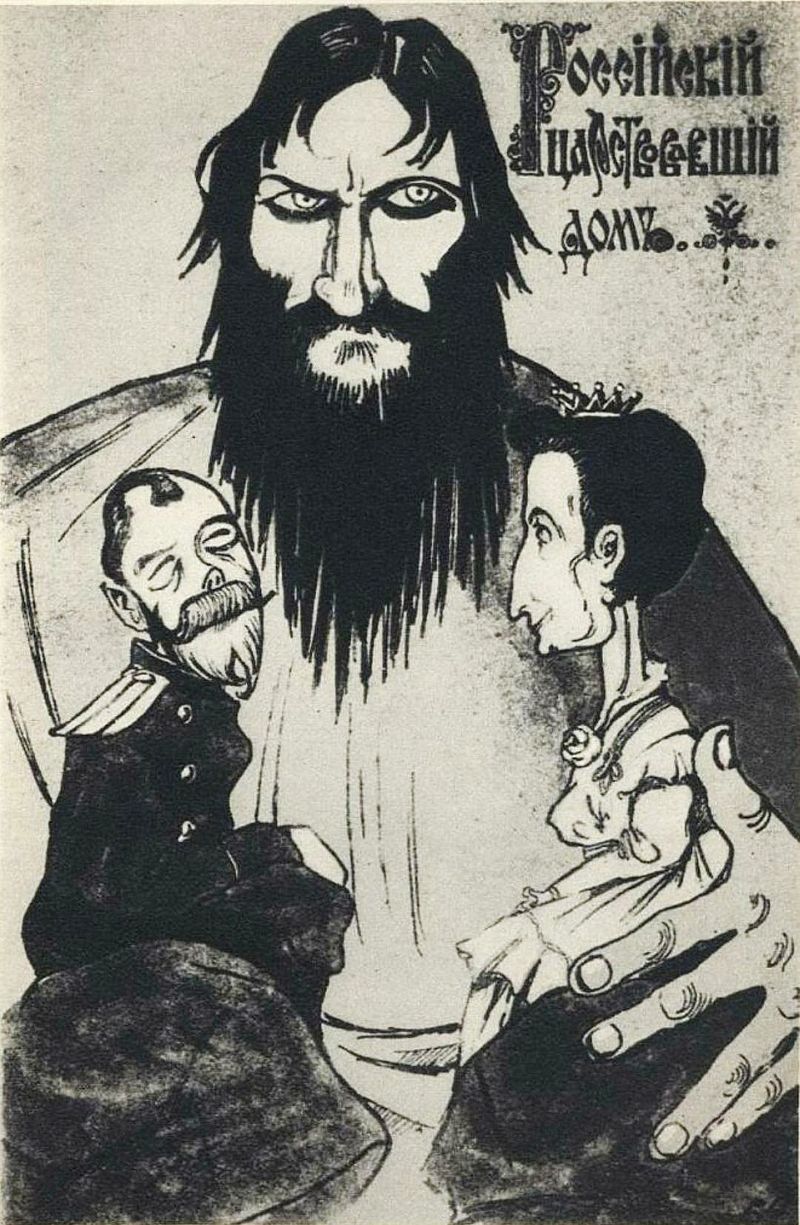
- Rasputin was interred at a small church that Vyrubova had been constructing at Tsarskoye Selo. The funeral was attended solely by the imperial family and a handful of their close associates. Rasputin's family did not receive invitations, although his daughters later met with the imperial family at Vyrubova's residence on that same day.
- The imperial family intended to construct a church over Rasputin's burial site. However, his remains were unearthed and cremated by a group of soldiers under the orders of Alexander Kerensky shortly after Nicholas relinquished the throne in March 1917 to prevent his grave from becoming a focal point for loyalists of the former regime.
- The death of Rasputin had far-reaching consequences, signalling the beginning of the end for the Romanov dynasty and contributing to the upheaval that culminated in the Russian Revolution of 1917. The involvement of nobles in his death worsened the existing dissatisfaction and loss of faith in the monarchy, ultimately speeding up its collapse.
Image Sources
- https://upload.wikimedia.org/wikipedia/commons/thumb/7/71/Rasputin_PA.jpg/800px-Rasputin_PA.jpg
- https://upload.wikimedia.org/wikipedia/commons/5/5a/%CE%A1%CE%B1%CF%83%CF%80%CE%BF%CF%8D%CF%84%CE%B9%CE%BD.jpg
- https://upload.wikimedia.org/wikipedia/commons/thumb/d/dd/Rasputin_listovka.jpg/800px-Rasputin_listovka.jpg
Frequently Asked Questions
- Who was Grigori Rasputin?
Grigori Rasputin was a Russian self-proclaimed holy man who gained significant influence over Tsar Nicholas II and Tsarina Alexandra of Russia, mainly due to his apparent ability to alleviate their son's haemophilia symptoms.
- What was Rasputin's influence on the Russian monarchy?
Rasputin's influence on the Russian monarchy was profound. He became a close advisor to Tsarina Alexandra, often exerting significant political influence over the royal family's decisions.
- How did Rasputin die?
Rasputin was assassinated on 30 December 1916. He was lured to the home of a nobleman, Prince Felix Yusupov, and given poisoned wine and cakes. When the poison seemed to have no effect, Rasputin was shot multiple times and eventually drowned in the Neva River. The exact details surrounding his death remain somewhat mysterious and have inspired various theories and legends.
